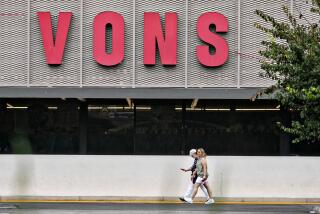Staples Plans to Open 4 Stores Here Next Year : Retailing: The Boston-based discount firm will be making its initial foray into the lucrative California market with its office-supply outlets.
- Share via
Who says paper clips don’t count?
With the average office employee using more than $400 worth of office supplies every year, for many small businesses, keeping track of the paper clips and Paper Mates is more than pinching pennies. It’s a necessity.
Enter Staples Inc., the Boston-based firm that has emerged as one of the nation’s top discount office super-store chains, offering businesses an array of office supplies at bargain prices.
And soon Staples will be in Orange County. Company officials said Monday that the firm is coming to California, making its debut next summer in Orange County with the opening of four office-supply super-stores.
“We’re starting with a tight, geographic area,” said Todd Krasnow, company spokesman. “And we’re convinced that Orange County can support a very strong market.”
The company, which now operates 37 stores in nine Northeastern states, wants to break into the lucrative California market as part of its nationwide expansion. Staples hopes to have 139 stores nationwide and 34 throughout California by April, 1993.
The company recently began advertising for store managers for both Orange and Los Angeles county locations. The firm declined to identify the exact locations of the stores, which will each be about 18,000 square feet. Company executives see Orange County, and California as a whole, as ideal for its expansion because of the state’s demographics--with high personal income and a booming economy. It also considers Orange County to be relatively under-served.
“The density of small to mid-sized businesses--with one to 100 employees--is enormous there,” Krasnow said. Moreover, the growth of white-collar employment in California has been among the biggest in the country.
“We felt we could stand out, from a competitive point of view,” said Thomas G. Stemberg, chairman of Staples and a former supermarket executive.
The move will mean going head-to-head with such competitors as Office Club and HQ Office Supplies Warehouse here. Elsewhere, Staples competes with BizMart, WORKplace, Office America and Office Depot.
All are part of the changes in the office supply industry that began several years ago when Staples pioneered the no-frills, super-store concept.
The idea behind office super-stores is to give large savings on everything an office uses, from calculators and calendars to mailing labels and microwave ovens. Staples’ current catalogue, for example, offers 8 1/2-by-11-inch legal pads for $3.49 per dozen--while local stationers this week were quoting $6.49 to $18.57 for substantially the same merchandise.
The stores can give the discounts because they use a time-honored retail concept: buying in bulk and skipping the middlemen when possible. By buying goods directly from manufacturers or wholesalers, savings can be passed along to customers.
The office-supply super-stores can get discounts of up to 50% from the retail price. Smaller companies, however, traditionally have had to order from dealers’ catalogues, getting discounts at best of only 10 to 15%.
The market office-supply super-stores are after is gigantic. Retail sales of office products in the United States have been estimated as high as $80 billion to $100 billion today by industry analysts.
Super-stores only command about $2 billion of that now but could capture from $8 billion to $12 billion within the next five years, industry analysts say.
Stemberg saw the demand four years ago when he decided to create a discount supply store for small businesses--a sort of Toys-R-Us for small offices ranging from design consultants to accountants to real estate firms. Similar super-store and warehouse-type operations have cropped up in a variety of retail businesses--selling everything from computers to groceries--in recent years.
“Some of the best opportunities in the world are the most obvious ones,” Stemberg said in an interview this week. “I was looking for a large, fast-growing business which was under-served by modern distribution channels.”
His instincts proved right.
In addition to buying in bulk and cutting out the middlemen, the company keeps costs down through the use of large distribution centers. Rather than manufacturers having to deliver merchandise directly to several stores, they can save on freight by delivering in bulk to one location.
That so-called hub-and-spoke strategy has allowed Staples to lower freight costs and payroll expenses, as well as to have smaller stores because less inventory must be stocked on-site. By buying in bulk for delivery to one site, Staples is able to negotiate better prices.
Another central distribution center is planned for Southern California at an undisclosed location, company officials said.
The other key to Staples’ success has been its marketing. By requiring customers to become members (at no cost and with no membership requirements), the chain is able to keep tabs on who buys what and how often. That, in turn, allows Staples to target its shoppers.
With merchandise displayed on bare-metal shelves on concrete floors, Staples’ stores stock up to 5,000 items and generate an average of $507 in sales per square foot. That compares to Office Depot’s per-square-foot sales of $364 and Office Club’s of $406, Krasnow said.
Still Staples has only been profitable for the past six months, when for the first two quarters of fiscal 1990, ended Oct. 28, it recorded net income of $1.5 million on sales of $86.5 million. That compares to a $3.9-million loss on sales of $47.7 million for the comparable period last year.
STAPLES AT A GLANCE
Incorporated: November, 1985.
Number of stores: 37 in nine states.
Annual revenue: $120 million. *
Net income/loss: -1.9 million. *
* Year ending April 29, 1989.
STAPLES--PROGRESS BY QUARTER
Operating Sales Income/(Loss) Quarter Stores (Millions) (Millions) Q4 (ended 4/29/89) 24 $37.3 $1.2 Q3 (ended 4/29/89) 23 34.8 .9 Q2 (ended 4/29/89) 22 28.2 (1.4) Q1 (ended 4/29/89) 18 19.5 (2.6) Q4 (ended 4/30/88) 16 14.9 (3.3) Q3 (ended 4/30/88) 9 11.9 (1.7) Q2 (ended 4/30/88) 7 8.3 (1.7) Q1 (ended 4/30/88) 5 4.6 (1.7) Q4 (ended 5/2/87) 3 3.4 (1.0) Q3 (ended 5/2/87) 2 2.8 (.6) Q2 (ended 5/2/87) 1 1.7 (.4) Q1 (ended 5/2/87) 1 .8 (.6)
Source: Staples
THE OFFICE PRODUCTS INDUSTRY
Nine-year annual compound growth rate 1979-1988E:
Office Supplies: 4.8%
Office Furniture: 8.3%
Office Machines: 7.4%
Office Micro Computers: 32%
Office Total: 8.4%
More to Read
Inside the business of entertainment
The Wide Shot brings you news, analysis and insights on everything from streaming wars to production — and what it all means for the future.
You may occasionally receive promotional content from the Los Angeles Times.









